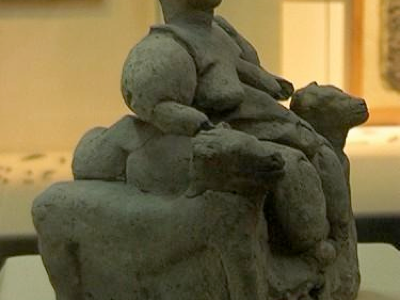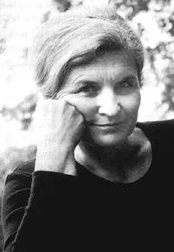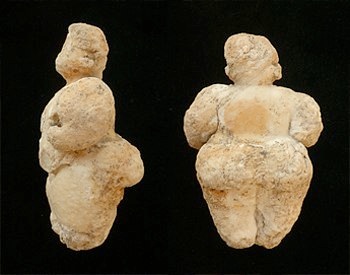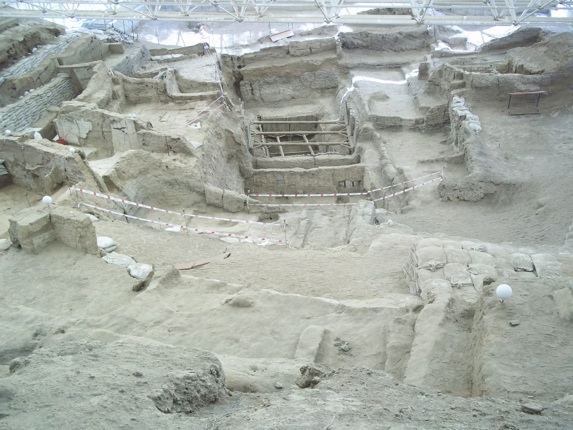The current excavation at Çatal - and Ian Hodder’s philosophy - represent a radical departure from the classic archaeological method. Instead of archaeologists making definitive interpretations of the finds (we know that this is the wall of a house and we’re certain this over here is a shrine) Ian accepts and allows different interpretations from different groups or individuals with disparate views. Understandably, this makes the work here much more diverse, complex, difficult, and often controversial.
When James Mellaart, who belonged to the earlier generation of archaeologi
sts, dug here back in the early 1960’s, he made some deterministic statements.
When James Mellaart, who belonged to the earlier generation of archaeologi
sts, dug here back in the early 1960’s, he made some deterministic statements.
| One of them was the one about a tiny figurine about the corpulent woman flanked by two leopards, and coined by Mellaart as the “Mother Goddess of Çatalhöyük.” Mellaart’s claim that the figurine surely represented a fertility goddess was further enforced and publicized the world over by Marija Gimbutas, a Lithuanian-American anthropologist and self-proclaimed expert of the goddess story. This figurine, and others like it, brought Mellaart and Gimbutas to the conclusion that the people of Çatalhöyük not only worshipped a female deity but that they were also a society in which women were in charge. Gimbutas developed her theory of female dominance while excavating Neolithic sites in Southeast Europe. |
Gimbutas' claim is that the Neolithics of South Europe were a peaceful people who venerated female goddesses until the invasion of warrior societies from the north. She writes: "Little by little, we became a patriarchal and warrior society. We dominate nature; we don't feel we belong to her. This warrior society goes back to the Indo- European conquest of Europe, which eventually led to such people as Stalin and Hitler. We have to come back to our roots."
The news that a goddess worshipping Neolithic community was discovered in Turkey spread across the globe like wild fire. By the 70s and 80s - as the feminist movement was gaining ground - it became a cause celebre for goddess worshippers everyhere. Each season goddess worshipping women in the busloads would arrive at Çatal. They would get naked, dance around the mounds, and eat the dirt. This, of course, was rather shocking for the archeaologists but more so for the ultra conservative muslim villagers, some of whom had jobs at the site.
I understand this went on for some years. Ian Hodder tells me that the Turkish Government told him to ban these women from coming but he refused to do so. You have to understand, Ian’s every move, and everything that happens at Çatal is under heavy government scrutiny. So this decision by him, did have some risks.
Ian handled the situation quite elegantly. Keeping with his all-inclusive, reflexive philosophy, he decided to give these women - and their particular interpretation - a voice. He welcomed them and started a dialogue with them.
The news that a goddess worshipping Neolithic community was discovered in Turkey spread across the globe like wild fire. By the 70s and 80s - as the feminist movement was gaining ground - it became a cause celebre for goddess worshippers everyhere. Each season goddess worshipping women in the busloads would arrive at Çatal. They would get naked, dance around the mounds, and eat the dirt. This, of course, was rather shocking for the archeaologists but more so for the ultra conservative muslim villagers, some of whom had jobs at the site.
I understand this went on for some years. Ian Hodder tells me that the Turkish Government told him to ban these women from coming but he refused to do so. You have to understand, Ian’s every move, and everything that happens at Çatal is under heavy government scrutiny. So this decision by him, did have some risks.
Ian handled the situation quite elegantly. Keeping with his all-inclusive, reflexive philosophy, he decided to give these women - and their particular interpretation - a voice. He welcomed them and started a dialogue with them.
| In the meantime Çatal archaeologists found no real evidence to back the Goddess theory. The notion that Mellaart so determinedly put forward was proving to be false. These small figurines were found everyhere on the site. Some of them - including the very famous one - were found in middens - areas where the Neolithics dumped their trash. As I grow to understand the method and theory, I’m seeing that you can have any interpretation or make up any story that you want but you must back it with hard evidence. The archaeologists saw no hard evidence for the Goddess. |
Figures suggesting the goddess are found at the site regularly. Yesterday, when I was visiting the west mound, the site director said “we found a goddess!” and she handed it over to me. A very small, worn little figure (a lot like the one on the right in the below photo.) I put it down because I wanted to photograph it but by the time I took out my camera, she had snatched it away and placed it in its plastic bag. She was right, of course. The object seemed quite ordinary and I had treated it carelessly. Not good, Sinan.
I understand the controversy abated for a while. Ian said the women even stopped coming. This year, however, a new group showed up. I wasn’t there but Christopher Knüsel from the human remains team said it was rather shocking. During their meeting with Ian, the women became very aggressive. They claimed that it was sacrilegous for a man (Ian) to violate this sacred territory. They said he was raping the goddess. Knowing Ian this does seem rather comical. He’s such a calm, centered and compassionate man. Yet he would take these assaults composedly and even try to establish further dialogue. So the goddess still lives - and the controversy continues.
Sadly, Mellaart passed away during my visit to the site, on Sunday July 29. Archaeologists paid their respect with a moment of silence and a walk through the area that he excavated. As controversial a figure he was, and as careless his method may have been, he is still respected as an important figure and a pioneer. He will always be remembered as the man who discovered Çatalhöyük.
The other controversy, somewhat related to the one of matriarchal society, is the theory that Çatal was an egalitarian society. That men and women were equal and they lived in relative piece. I don’t feel qualified to say much about this except to say my vulnerability - like many others - is the inclination, or the desire to wish something like that were true. Of course many of us romanticize the past and even believe things were better back then, before civilization emerged and it all went to seed. We want to believe there was utopia and perhaps we can achieve it again. As romantic as this notion is, it seems Çatalhöyük does offer some promise for the possibility of such an early community. Some believe there are no weapons found. Christopher Knüsel argues that there are some objects uncovered that suggest that they could have been used as weapons. There are some skulls found with clear gash marks and, of course there are all those beheadings.
There are a number of headless burials at Çatal. These people did things with their dead we may never completely understand. The bodies were bunched up and buriend in fetal positions. Some individuals were beheaded. Some of skulls were plastered, even painted, and kept. Nobodyknows if this is a sort of reverence for the dead - or a ritual to celebrate ancestors, or something much darker and morbid. Nobody knows if the bodies are beheaded while alive or after death. Headless bodies are also seen on the art work.
From the analysis of human remains, we can tell that men and women lived similar lives. It seems that both sexes engaged in the same amount of vigorous activity and that they ate the same food. Women were beheaded at burial as well as men. Although, while talking to me, most of the archeologists were circumspect about the question of an egalitarian society, Ian seemed a bit more convinced about it. Evidence points to it, but as things in pre-historic archaeology, a definite answer is not possible.
Part of what drew me to this project was this question of interpretation. That much of interpretation has to do with the individual’s own experience and point of view. That there is no objective interpretation. Ian and his colleagues are extremely mindlful of this. They know all opinion is biased. It seems to me a tricky territory - especially for scientists - to navigate.
If I were to give my “biased,” uncultured and uneducated guess, I’d say something like: this was the moment in history when humans first settled down and formed communities. They developed agriculture which was the key to a sedentary civilization. They built walls and houses to live in them. It seems to me that this is the first step toward an individualistic, material and ownership based society. Do you see where the bias is in that???
I understand the controversy abated for a while. Ian said the women even stopped coming. This year, however, a new group showed up. I wasn’t there but Christopher Knüsel from the human remains team said it was rather shocking. During their meeting with Ian, the women became very aggressive. They claimed that it was sacrilegous for a man (Ian) to violate this sacred territory. They said he was raping the goddess. Knowing Ian this does seem rather comical. He’s such a calm, centered and compassionate man. Yet he would take these assaults composedly and even try to establish further dialogue. So the goddess still lives - and the controversy continues.
Sadly, Mellaart passed away during my visit to the site, on Sunday July 29. Archaeologists paid their respect with a moment of silence and a walk through the area that he excavated. As controversial a figure he was, and as careless his method may have been, he is still respected as an important figure and a pioneer. He will always be remembered as the man who discovered Çatalhöyük.
The other controversy, somewhat related to the one of matriarchal society, is the theory that Çatal was an egalitarian society. That men and women were equal and they lived in relative piece. I don’t feel qualified to say much about this except to say my vulnerability - like many others - is the inclination, or the desire to wish something like that were true. Of course many of us romanticize the past and even believe things were better back then, before civilization emerged and it all went to seed. We want to believe there was utopia and perhaps we can achieve it again. As romantic as this notion is, it seems Çatalhöyük does offer some promise for the possibility of such an early community. Some believe there are no weapons found. Christopher Knüsel argues that there are some objects uncovered that suggest that they could have been used as weapons. There are some skulls found with clear gash marks and, of course there are all those beheadings.
There are a number of headless burials at Çatal. These people did things with their dead we may never completely understand. The bodies were bunched up and buriend in fetal positions. Some individuals were beheaded. Some of skulls were plastered, even painted, and kept. Nobodyknows if this is a sort of reverence for the dead - or a ritual to celebrate ancestors, or something much darker and morbid. Nobody knows if the bodies are beheaded while alive or after death. Headless bodies are also seen on the art work.
From the analysis of human remains, we can tell that men and women lived similar lives. It seems that both sexes engaged in the same amount of vigorous activity and that they ate the same food. Women were beheaded at burial as well as men. Although, while talking to me, most of the archeologists were circumspect about the question of an egalitarian society, Ian seemed a bit more convinced about it. Evidence points to it, but as things in pre-historic archaeology, a definite answer is not possible.
Part of what drew me to this project was this question of interpretation. That much of interpretation has to do with the individual’s own experience and point of view. That there is no objective interpretation. Ian and his colleagues are extremely mindlful of this. They know all opinion is biased. It seems to me a tricky territory - especially for scientists - to navigate.
If I were to give my “biased,” uncultured and uneducated guess, I’d say something like: this was the moment in history when humans first settled down and formed communities. They developed agriculture which was the key to a sedentary civilization. They built walls and houses to live in them. It seems to me that this is the first step toward an individualistic, material and ownership based society. Do you see where the bias is in that???






 RSS Feed
RSS Feed